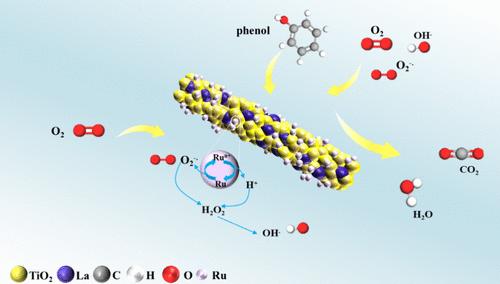当前位置:
X-MOL 学术
›
Ind. Eng. Chem. Res.
›
论文详情
Our official English website, www.x-mol.net, welcomes your
feedback! (Note: you will need to create a separate account there.)
Fabrication of a Mesoporous La-Doped TiO2 Nanofiber-Supported Ru Catalyst by Electrospun Technology for Efficient Catalytic Wet Air Oxidation of Phenol
Industrial & Engineering Chemistry Research ( IF 3.8 ) Pub Date : 2024-09-24 , DOI: 10.1021/acs.iecr.4c02183 Bingzheng Zhao, Rongji Cui, Zhicheng Tang, Qingchun Wang
Industrial & Engineering Chemistry Research ( IF 3.8 ) Pub Date : 2024-09-24 , DOI: 10.1021/acs.iecr.4c02183 Bingzheng Zhao, Rongji Cui, Zhicheng Tang, Qingchun Wang

|
Catalytic wet air oxidation (CWAO) of phenol has garnered significant attention due to its versatility and notable economic advantages. In this work, electrospinning technology was employed to prepare mesoporous TiO2 nanofibers, which were subsequently loaded with Ru for CWAO of phenol. Considering the flexibility of electrospinning, lanthanum as a promoter and P123 as a pore structure modifier were added to the precursor solution to enhance the performance of the support. Finally, the influence mechanism of La and P123 on the catalytic performance of Ru-based catalysts was investigated by various characterization analyses, including XRD, Raman, BET, HRTEM, XPS, and H2-TPR, as well as catalytic activity and stability tests. The results indicated that the addition of La inhibited rutile TiO2 formation, reduced TiO2 grain size, improved Ru dispersion, and increased oxygen vacancies, thereby enhancing the catalytic activity. The addition of P123 further enhanced the promoting effect of La, resulting in better La dispersion, more surface active oxygen, and stronger Ru-support interactions, thereby significantly improving catalytic activity. For Ru/LaTiOx-IP, the initial COD conversion was 94.2% at 200 °C under 2 MPa O2 partial pressure and can be maintained higher than 80% in five consecutive cycles. At the end of the reaction, the catalyst was also examined for carbon deposition, metal leaching, and valence changes, of which carbon deposition and metal leaching were found to be important factors affecting the performance and stability of the catalyst.
中文翻译:

静电纺丝技术制备介孔 La-掺杂 TiO2 纳米纤维负载的 Ru 催化剂
苯酚的催化湿式空气氧化 (CWAO) 因其多功能性和显着的经济优势而受到广泛关注。在这项工作中,采用静电纺丝技术制备介孔 TiO2 纳米纤维,随后用 Ru 负载苯酚的 CWAO。考虑到静电纺丝的柔韧性,在前驱体溶液中加入镧作为促进剂和P123作为孔结构改性剂,以增强载体的性能。最后,通过各种表征分析,包括 XRD、Raman、BET、HRTEM、XPS 和 H2-TPR,以及催化活性和稳定性测试,研究了 La 和 P123 对 Ru 基催化剂催化性能的影响机制。结果表明,La的添加抑制了金红石型TiO2的形成,减小了TiO2的晶粒尺寸,改善了Ru的分散性,增加了氧空位,从而提高了催化活性。P123 的加入进一步增强了 La 的促进作用,导致 La 分散性更好,表面活性氧更多,Ru-负载相互作用更强,从而显著提高催化活性。对于 Ru/LaTiOx-IP,在 200 °C、2 MPa O2 分压下,初始 COD 转化率为 94.2%,并且可以连续 5 次循环保持在 80% 以上。在反应结束时,还检查了催化剂的碳沉积、金属浸出和价态变化,其中碳沉积和金属浸出是影响催化剂性能和稳定性的重要因素。
更新日期:2024-09-24
中文翻译:

静电纺丝技术制备介孔 La-掺杂 TiO2 纳米纤维负载的 Ru 催化剂
苯酚的催化湿式空气氧化 (CWAO) 因其多功能性和显着的经济优势而受到广泛关注。在这项工作中,采用静电纺丝技术制备介孔 TiO2 纳米纤维,随后用 Ru 负载苯酚的 CWAO。考虑到静电纺丝的柔韧性,在前驱体溶液中加入镧作为促进剂和P123作为孔结构改性剂,以增强载体的性能。最后,通过各种表征分析,包括 XRD、Raman、BET、HRTEM、XPS 和 H2-TPR,以及催化活性和稳定性测试,研究了 La 和 P123 对 Ru 基催化剂催化性能的影响机制。结果表明,La的添加抑制了金红石型TiO2的形成,减小了TiO2的晶粒尺寸,改善了Ru的分散性,增加了氧空位,从而提高了催化活性。P123 的加入进一步增强了 La 的促进作用,导致 La 分散性更好,表面活性氧更多,Ru-负载相互作用更强,从而显著提高催化活性。对于 Ru/LaTiOx-IP,在 200 °C、2 MPa O2 分压下,初始 COD 转化率为 94.2%,并且可以连续 5 次循环保持在 80% 以上。在反应结束时,还检查了催化剂的碳沉积、金属浸出和价态变化,其中碳沉积和金属浸出是影响催化剂性能和稳定性的重要因素。













































 京公网安备 11010802027423号
京公网安备 11010802027423号